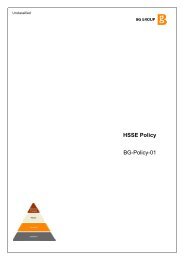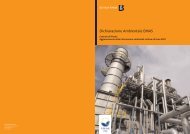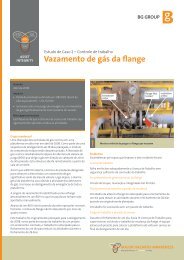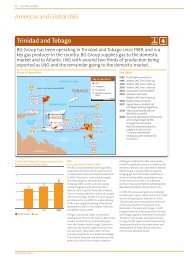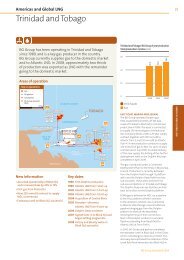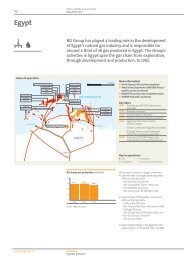HSSE Management Tours - BG Group
HSSE Management Tours - BG Group
HSSE Management Tours - BG Group
You also want an ePaper? Increase the reach of your titles
YUMPU automatically turns print PDFs into web optimized ePapers that Google loves.
3<br />
Key Integrity Barriers<br />
Topic 17 – Control of Ignition Sources<br />
• Potential ignition sources at hydrocarbon handling<br />
facilities must be strictly controlled. Areas of the<br />
plant where there is the potential for a hazardous<br />
(i.e. flammable) atmosphere to be present must<br />
have suitably rated electrical equipment. This<br />
may be intrinsically safe (incapable of providing<br />
enough energy to cause ignition) or explosion<br />
proof (sealed to prevent gas ingress, referred to as<br />
“Ex” equipment). The emergency shutdown (ESD)<br />
system will isolate all non-essential electrical<br />
equipment in the event of a major gas release, but<br />
equipment that is required to continue to function<br />
in an emergency must be appropriately rated. All<br />
electrical equipment requires periodic inspection,<br />
testing and maintenance to ensure that it is<br />
not damaged or degraded such that its rating is<br />
compromised.<br />
<strong>HSSE</strong> <strong>Management</strong> <strong>Tours</strong>:<br />
Asset Integrity Guide<br />
• Earth bonding is provided on equipment to prevent<br />
sparks due to stray current or static build-up.<br />
Lightning protection systems are provided to earth<br />
the currents from lightning strikes. Hot surfaces<br />
may also cause auto-ignition of flammable gas/air<br />
mixtures and so maximum surface temperatures<br />
are controlled in hazardous areas. Earth bonding<br />
and insulation materials require periodic inspection<br />
to ensure their integrity.<br />
• The activities of personnel present potential<br />
ignition sources. Non-sparking tools must be<br />
used. Hot work must be strictly controlled by the<br />
permit-to-work system. All temporary and portable<br />
equipment must be inspected and certified before<br />
being brought onto site, and either periodically<br />
recertified or removed.<br />
42



